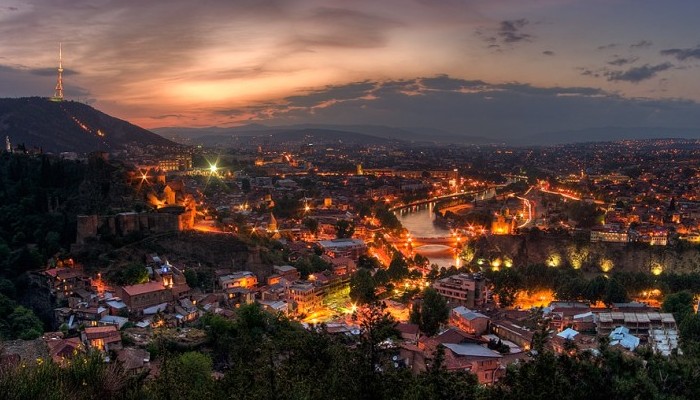About 1 million tourists visit Georgia every year
Georgia has to be one of the most
beautiful countries on earth
This is a place where the human hand has much enhanced that of nature. Georgia is one of the most beautiful countries with sublimely perched old churches, watchtowers and castles dotting its fantastic mountain scenery. Georgia is developing its tourism potential and making the full range of its attractions safely and readily accessible to travellers. Georgia's deeply complicated history has given it a fascinating cocktail of influences from Turkey, Russia, Persia, Central Asia and beyond, with a wonderful heritage of architecture and art. But today Georgia looks to Europe for its future and is the most Western in atmosphere of the three Caucasus countries.
Perhaps its greatest treasure is the Georgians themselves: warm, proud, high-spirited, cultured, obsessively hospitable and expert at enjoying life. This is a country where guests are considered a blessing. The abundant local wine flows freely, tables are laden with fine food and you'll never cease to be delighted by the warmth of your welcome. Tourist attractions include more than 2000 mineral springs, over 12,000 historical and cultural monuments, four of which are recognised as UNESCO World Heritage Sites..
Georgia is an ancient country of rugged mountains and very determined people. It is bordered by the Black Sea in the west, by Turkey and Armenia in the south, by Azerbaijan in the east, and Russia in the north. From outrageously beautiful towns of Svaneti and Kazbegi in the Caucasus mountains to Batumi, a fun-loving semitropical town on the Black Sea coastline, Georgia abounds in natural variety. Tbilisi, the capital and by far the biggest city, has the atmosphere of an age-old Eurasian crossroads, yet it's also a 21st-century city with eye-catching new architecture.

Night Tbilisi
Tbilisi is the largest city in Georgia. In the picture you can see the historical center of Georgia's capital.
Buildings here have a traditional Georgian architectural look with Middle Eastern influences.
Inhabited since the Paleolithic era, the first proto-Georgian tribes arrived by the 12th century BC. Throughout the 12th and 13th centuries AD, the Georgian Kingdom reached its peak, and the country expanded its cultural and political influence. It further expanded under the rule of Tamar, Queen of Georgia, in the late 1100's to early 1200's. Tamar built upon the success of the rulers before her, and controlled the Caucasus until 1213. Then Mongols attacked the area until the early 1300's. With the aid of King George V, that the Kingdom of Georgia was restored. The newly revitalized kingdom didn't last long, and in its weakened state the Persian Empire overpowered the eastern region of Georgia, while the Ottomans took control of the western region. Georgia didn't recover its territory until 1762 - however, by 1801, the country annexed by Russia.
Georgia declared their independence on May 26, 1918, after the Russian Revolution of 1917. This independence didn't last long, and the country was attacked and defeated by the Russian Red Army in 1921. Along with Armenia and Azerbaijan, Georgia was integrated into the Transcaucasian SFSR. Georgia declared its independence from Russia in 1991. As a result of the Rose Revolution in 2003, Georgian leaders improved and strengthened the capabilities of the country's economy. Tourism is an increasingly significant part of the Georgian economy.
Traditionally agricultural land - quite famous for its wines - tourism is on the front-burner in Georgia as international travel has increased - especially along the Black Sea coastal areas.
Georgian culture was influenced by Classical Greece, the Roman Empire, the Byzantine Empire, and later by the Russian Empire. Its culture enjoyed a golden age and renaissance of classical literature, arts, philosophy, architecture and science in the 11th century. Georgians have their own unique 3 alphabets which according to traditional accounts were invented by King Pharnavaz I of Iberia in 3rd century BC.
Georgian architecture has been influenced by many civilizations. There are several different architectural styles for castles, towers, fortifications and churches. The Upper Svaneti fortifications, and the castle town of Shatili in Khevsureti, are some of the finest examples of medieval Georgian castle architecture. Other architectural aspects of Georgia include Rustaveli Avenue in Tbilisi in the Hausmann style, and the Old Town District.
Georgian ecclesiastic art is one of the most notable aspects of Georgian Christian architecture, which combines classical dome style with original basilica style forming what is known as the Georgian cross-dome style. Cross-dome architecture developed in Georgia during the 9th century; before that, most Georgian churches were basilicas.
If you have never been to Georgia but heard that it's a country of beautiful landscapes and pretty towns, ancient monuments and culture, hospitable people and delicious cuisine, now you have a chance to travel around Georgia and discover for yourself this country of wonders.




